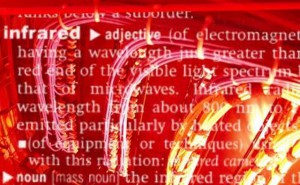Infrared lens is a subset of the entire electromagnetic spectrum. Like visible light, ultraviolet, X-rays and radio, infrared lens is carried by photons, which can be thought of as tiny bits of electromagnetic energy. The amount of energy carried by a photon is determined by the wavelength of light. X-rays, for example, have very high energy, while radio waves have low energy. Infrared photons carry less energy than visible light photons. The transparency or opacity of an object to infrared depends upon the specific characteristics of the molecules in the material.
The Infrared Spectrum
Infrared wavelengths are beyond the range of direct human perception, which is where an IR camera comes in handy.
Different definitions exist for the infrared spectrum. Everyone agrees that it begins at wavelengths just longer than visible light and extends out to much longer wavelengths, but the exact start and finish are a matter of choice. There are a few different typical classes of infrared camera, each uses a different wavelength region. Some use the near infrared wavelengths from about 0.8 micrometers (that’s 0.8 millionths of a meter) to about 1.5 µm (the symbol for micrometers). Others use mid-wave-IR (MWIR) wavelengths from about 3 to 5 µm, and still others use the long-wave (LWIR) region from 8 to 12 µm.

Lens Transmission
The material of your IR lens will have been selected to match the region of the spectrum in which the camera operates. For example, a near-IR camera could have a lens made from fused silica, magnesium fluoride or quartz. MWIR lenses are often made from silicon, while LWIR lenses are frequently made from germanium. A material will appear opaque to your lens if the transparent spectral region of the material doesn’t match the transparent region of the lens.
IR Transparency
Unfortunately, there’s no easy rule for extrapolating the visible look of a material into its transparency in the infrared. Because visible light and infrared light have different energy, they will act differently when traveling through a material. In general, visible light will interact with the electrons around an atom, while infrared light interacts with the bonds that hold molecules together. Because of this, almost every material that is transparent in visible light will block infrared radiation. So, if your lens is not designed for use at near-IR wavelengths, chances are anything you can see through will be opaque to your lens.
Finding More Materials
Most of the information available online is tailored towards helping people find materials that are transparent to infrared wavelengths, as opposed to opaque to those wavelengths. Still, where a material is not transparent, it will be opaque, so you can use those lists to find materials that don’t transmit at the same wavelengths as your lens. The best way, of course, is to test various materials with your camera.
This article comes from itstillworks edit released
